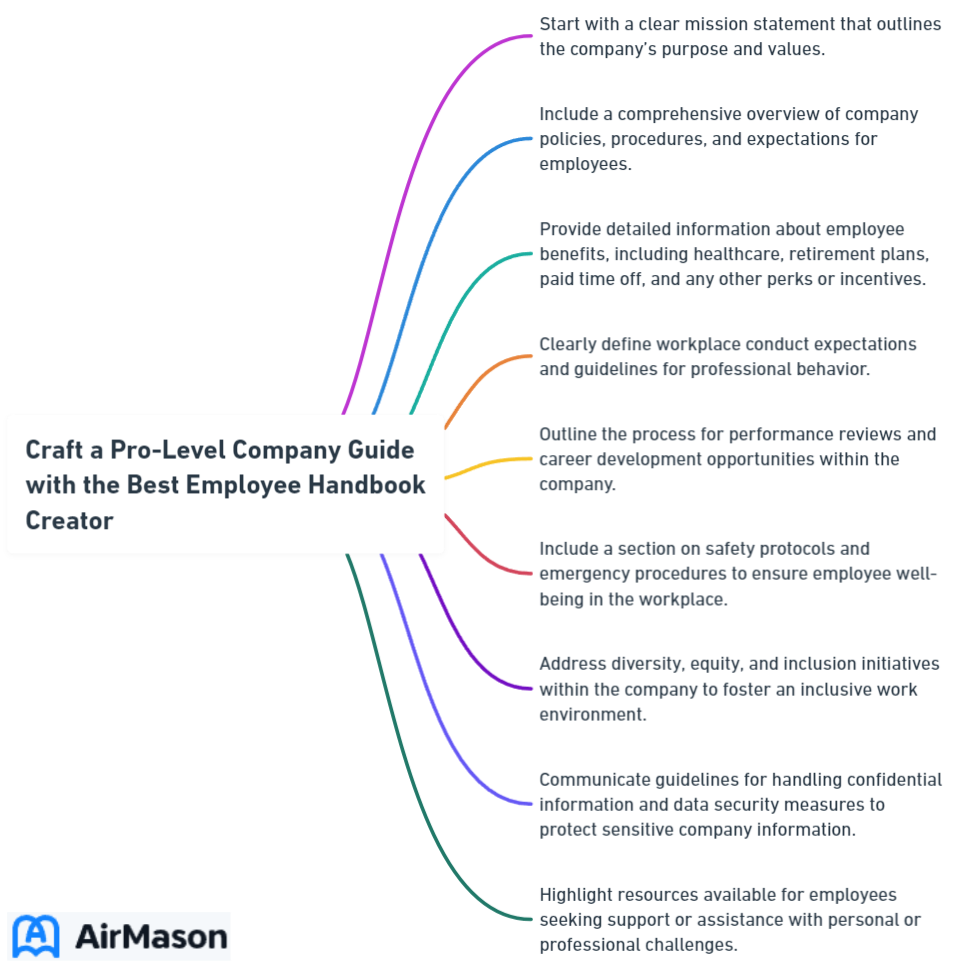
Looking for an employee handbook creator that straightforwardly aligns with your company’s culture and legal requirements? This article provides a pragmatic walkthrough of how to identify, compare, and utilize the best tools in the market to produce a clear, up-to-date, and engaging employee handbook, tailored to your business’s unique needs.
Key Takeaways
- It is crucial to select an employee handbook creator that offers extensive customization, ease of use, integration capabilities, and digital accessibility to ensure it meets the specific needs and branding of the business.
- A company’s employee handbook should be a living document, frequently updated to reflect changes in laws and workplace norms, while showcasing the company culture and integrating the brand’s identity effectively.
- Incorporating interactive elements and leveraging technology like AR in employee handbooks can enhance the user experience, making them more engaging and effective as onboarding tools and ongoing references for employees.
Selecting the Ideal Handbook Builder for Your Business
Choosing the right employee handbook creator is like selecting a tailored suit. It should fit your business perfectly, reflecting your unique voice and specific needs. Customizable templates provide a structured format, saving you time while ensuring a consistent flow that aligns with your brand aesthetics.
You might wonder how to identify the perfect builder for your business. Allow us to guide you.

Factors to Consider When Choosing a Handbook Creator
When choosing a handbook creator, consider it as a vital cog in your business machinery. It should offer:
- Extensive customization options, like Blissbook and Waybook, to enhance the employee handbook experience.
- Ease of use, as offered by tools like ClickUp Docs and ProProfs Knowledge Base, for managing your handbooks effectively.
- Integration capabilities with popular workplace tools, like Slite and Guru, to ensure your branding is consistent throughout the handbook.
- Digital accessibility, as provided by Igloo and ClickUp, to connect your employees with your policies and protocols at their fingertips.
Comparing Top Employee Handbook Creators
Choosing the right builder is all about comparing and contrasting. Various tools, such as SixFifty, issuu, BLR, and Trainual, offer features like intuitive user interfaces, real-time collaboration tools, customizable policy creation, and even interactive features like in-app screen recording. Pricing models also play a critical role, ranging from SHRM’s one-time fee of $400 to Guru’s $10/user/month, not forgetting free trials of varying durations.
Unique features like AirMason’s signature reporting and Guru’s AI-powered tools offer a range of customization options to make your employee handbook truly mirror your company’s persona.
Crafting Your Custom Employee Handbook with Ease

Creating a custom employee handbook is like crafting a masterpiece. It starts with:
- Identifying your organization’s core values
- Defining what your organization excels at
- Creating a consistent understanding throughout the organization, ensuring that everyone is on the same page
- Integrating custom policies reflecting your company’s unique aspects into the handbook
Now, we’ll delve into the process of crafting your handbook using a handbook template.
Step-by-Step Guide to Building Your Handbook
Building an employee handbook is a journey where every step counts. Start by reviewing other companies’ handbooks for inspiration, but remember, your handbook should reflect your company’s practices and culture. Involve management for valuable insights on necessary policies and their practical implementation.
Choose a customizable employee handbook template that suits your company’s needs and values. Finally, populate the template with your company’s distinctive policies and culture. Voila! Your custom employee handbook is ready.
Incorporating State and Federal Laws
While crafting your employee handbook, compliance with federal, state, and local laws is like the North Star, guiding you through the process. Tools like SHRM Employee Handbook Builder and resources like The Employment Law Handbook can guide you to incorporate state-specific policies and include all required employment law policies. Remember, copying and pasting policies from other sources could lead to legal liability.
Be sure to include all current federal policies and state applicable laws pertinent to your workforce, such as equal employment opportunity, anti-harassment, and anti-discrimination laws.
Keeping Your Handbook Up to Date
An employee handbook is a living document, evolving with changes in federal, state, and local laws. Regular updates at least annually or whenever employment laws change ensure compliance and relevance. Preparation for new laws taking effect at the beginning of each year keeps your handbook current.
And let’s not forget soliciting employee feedback for a handbook that meets their needs and clarifies policies. After all, an updated handbook is a valuable handbook.
Showcasing Company Culture Through Your Handbook

Your employee handbook is a canvas that showcases your company culture in vibrant colors. It defines your company’s culture and values at the outset, guiding the creation of policies and procedures within the handbook. Starting the handbook with your company’s background and mission instills your organization’s culture, values, mission, and goals.
You might ask how to embed your brand identity and effectively communicate your policies. Here’s how.
Valve Employee Handbook
The Valve Employee Handbook serves as a cornerstone document outlining the unique culture and philosophy at Valve Corporation. This comprehensive guide is designed to empower employees with autonomy, creativity, and accountability in their work. With its emphasis on flat organizational structure and fluidity, the Valve Employee Handbook embodies the company’s commitment to fostering a dynamic and collaborative workplace environment. It outlines principles such as self-management, meritocracy, and continuous learning, providing employees with the framework to thrive and innovate within the company’s diverse projects and initiatives.
Infusing Your Brand Identity
Infusing your brand identity into the handbook is like adding a secret ingredient to a recipe. It starts with the company’s brand colors and typography, creating a handbook that visually aligns with your brand identity. High-quality graphics and images reflect your brand’s visual language, while a consistent brand voice builds employee trust.
Your company’s mission, vision, and values should be clearly summarized to ensure understanding of your organizational culture. And let’s not forget to humanize the handbook content with real-life stories and testimonials, increasing employee connection and engagement.
Communicating Your Company Policies Effectively
Communication is the key to a successful employee handbook. Here are some tips to make your policies clear, concise, and approachable using HR approved language:
- Use clear and reader-friendly language consistent with your company’s brand voice.
- Engage your employees with welcoming statements and catchy headings.
- Include optimized images to make complex policies more digestible.
Remember, balance is essential. Avoid unnecessary legalese and in-depth company procedures. Instead, provide concise summaries with links to full policy documents for a more effective and comprehensive employee handbook.
Enhancing Employee Experience with Interactive Features
An employee handbook is not just a static document. It’s an interactive tool that enhances the employee experience. Incorporating interactive content like podcasts to convey information about employee benefits, or HR automation tools offering 24/7 access to HR services, can engage employees like never before.
You might be wondering how to incorporate these interactive features. Here’s the breakdown.
The Role of Visual Elements

Visual elements in your handbook are like stars in the night sky, guiding your employees through the complex information. Infographics, charts, and images can improve comprehension and retention of complex handbook information. Visual storytelling and detailed text-based visuals, like annotated diagrams, can convey complex handbook information more effectively and quicker than text alone.
Ultimately, the value of a picture cannot be overstated. It has the power to convey a message more effectively than a thousand words.
Adding Interactivity to Your Handbook

Adding interactivity to your handbook is like adding a sprinkle of magic. Here are some ways you can do it:
- Include multimedia content such as videos and audio to accommodate different learning styles and improve retention and understanding of handbook material.
- Use interactive diagrams to help visualize complex concepts and make them easier to understand.
- Incorporate quizzes and interactive exercises to test knowledge and engage readers in an active learning process.
These interactive elements will transform your handbook from a static word document to a dynamic and engaging resource.
Interactive quizzes prompt employees to engage with the handbook content regularly, reinforcing the use of the handbook as a continuous reference point for information.
Streamlining HR Tasks with Automated Handbook Tools
HR automation is like a magic wand that can significantly reduce labor costs. A well-crafted employee handbook with automated tools can streamline HR tasks, reducing the need for manual work and lowering headcount in the HR department. An annual subscription for the employee handbook creator ensures the handbook is kept up to date over time, reducing the need for frequent manual revisions.
You might be curious about how to blend these handbook tools with HR systems and secure its distribution and accessibility. Here’s the answer.
Integration with HR Systems
Integrating your handbook creator with HR systems is like creating a powerful alliance. It reduces human error, improves compliance with legal changes, and enhances data privacy and security. Employee handbook software can sync with HR Information Systems (HRIS) to offer a single source of truth for company policies and guidelines, accessible to both HR teams and employees.
Collaborative and feedback tools support real-time contributions and reviews of policy changes, keeping your handbook dynamic and up-to-date.
Distribution and Accessibility
Distributing your handbook is like planting seeds in a garden. It can be distributed both digitally via a company intranet or web portal, providing online access, and in hard copy to accommodate employee preferences and ensure accessibility. Digital distribution is cost-effective and allows for easy handbook updates. Accessibility is supported by clear headings, breadcrumbs, keyword searches, and mobile-friendly design.
Acknowledgment tracking features ensure that employees have read and comprehended the policies contained within the handbook, making it a consistent foundation for all employees and providing consistent treatment.
Legal Compliance and Consulting Experts
Navigating the legal landscape of an employee handbook can be tricky. It’s vital to ensure that every aspect of the handbook complies with non-discrimination policies, compensation laws, and is generally legally up-to-date. Consulting with legal experts during the handbook’s creation ensures adherence to all legal mandates and helps in navigating the complex legal requirements for compliance.
You might ask how to ensure your handbook is up-to-date with current laws and how to access HR and legal advice. Let’s discover.
Ensuring Your Handbook Reflects Current Laws
Ensuring your handbook reflects current laws is like aligning your compass to the North Star. State laws may specify required content for employee handbooks, which can differ from federal laws and vary from state to state. The inclusion of federal anti-discrimination laws and information about employees’ rights under the Fair Labor Standards Act (FLSA) and the Family and Medical Leave Act (FMLA) is crucial.
Tools like Handbooks.io can directly incorporate relevant laws into the employee handbook, ensuring compliance and avoiding legal pitfalls.
Access to HR and Legal Advice
Accessing HR and legal advice is like having a trusted guide on your journey. Professional support can significantly aid small to medium-sized businesses in achieving legal compliance within their employee handbooks. A Professional Employer Organization (PEO) can provide the expertise necessary to create employee handbooks that adhere to applicable state and federal regulations.
Platforms like SixFifty’s Employment Docs ensure legal compliance and offer ongoing updates in response to legislative changes, helping you navigate the legal landscape with ease.
Onboarding and the Employee Handbook
The role of the employee handbook in onboarding new employees is like the role of a compass for a sailor. New employees can benefit from the opportunity to:
- Understand the company culture
- Understand the expectations and their role within the larger organization
- Quickly acclimate to their new work environment
The introduction of the handbook sets the tone for an employee’s journey in the company, making a critical first impression.
You might be wondering how to integrate the handbook smoothly into new hire training and utilize it as an ongoing reference. Here’s our guide.
Seamless Integration into New Hire Training
Seamless integration of the handbook into new hire training is like smoothly merging two rivers. Digital employee handbooks can make the onboarding process smoother by serving as a centralized hub for company policies, procedures, and guidelines.
Incorporating digital handbooks into the onboarding checklist enhances engagement from day one. Here’s how to introduce the handbook to new hires:
- Schedule a dedicated session where HR walks them through the document.
- Highlight key sections and address any questions they may have.
- Foster understanding and compliance by ensuring new hires are familiar with the handbook.
This approach will help new hires feel more engaged and informed from the start.
Using the Handbook as an Ongoing Reference
A well-crafted employee handbook is like a lighthouse, guiding employees throughout their journey in the company. It should be positioned as a dynamic and living document, reflecting the evolving nature of the company. Ensuring the handbook is easily accessible and user-friendly encourages employees to consult it regularly.
Regular updates and announcements about new policies or procedures keep staff engaged with the handbook’s content. After all, an engaged employee is a productive employee.
Planning for the Future: Evolving Your Employee Handbook
As we look towards the future, the employee handbook must also evolve. The future of employee handbooks is shaped by ongoing changes in the workplace. Employee handbooks can remain current by incorporating new sections relevant to evolving workplace norms, such as mental health and remote working policies.
You might ask how to adjust to these changes and make use of technology for future handbooks. Here’s the answer.
Adapting to Changes in Workplace Norms
Adapting to changes in workplace norms, including workplace conduct, is like changing sails to catch the wind. Updates to employee handbooks should be comprehensive, covering all relevant and important policies, including remote work, mental health, and diversity, and align with the company’s mission and culture.
Leveraging Technology for Next-Gen Handbooks
Leveraging technology for next-gen handbooks is like upgrading your old car to a self-driving one. Advanced technologies such as augmented reality (AR) can be integrated into employee handbooks to enhance their utility. Augmented reality (AR) in digital handbooks offers immersive training experiences that make policy explanations more interactive.
Future advancements in employee handbooks may include a variety of interactive features ranging from embedded videos to AR experiences.
Summary
From selecting the ideal handbook builder to planning for the future, we have navigated the world of crafting a pro-level company guide with the best employee handbook creator. We’ve delved into the importance of customization, interactivity, legal compliance, and the role of the handbook in onboarding new employees. As we conclude our journey, remember that a well-crafted employee handbook is not just a document, it’s a reflection of your company’s culture, values, and expectations. It’s your compass, guiding your employees throughout their journey in your organization.
Amazon Employee Policies and Procedures PDF
Accessing the Amazon employee policies and procedures PDF is essential for all employees to understand the company’s guidelines and expectations. This comprehensive document outlines various aspects of employment, including code of conduct, benefits, disciplinary procedures, and more. By familiarizing themselves with this PDF, employees can ensure they are in compliance with Amazon’s policies and procedures, contributing to a positive work environment and fostering professionalism within the organization.
Frequently Asked Questions
How do I make my own handbook?
To make your own handbook, follow these steps: create an outline or draft, summarize key points, decide on your tone of voice, use a professional document creator, use a ready-made template, run it by your legal team, and then publish it. This will help you create a comprehensive and professional handbook.
Who creates employee handbook?
The employee handbook is created by the employer or HR department, typically with input from legal counsel to ensure compliance with laws and regulations. Legal counsel should review the finalized policies before they are included in the handbook.
How do you structure a handbook?
To structure a handbook, include sections such as Introduction & Welcome, Workplace Commitments, Company Policies and Procedures, Employment Classification, Attendance Policies, Leave Policies, Work Performance, and Discipline Policy. These sections help to create a comprehensive and organized employee handbook.
How much does it cost to create an employee handbook?
Creating an employee handbook typically costs anywhere from $1,000 to $5,000, with additional costs for each state’s laws. It is possible to write your own employee handbook.
What factors should I consider when choosing a handbook creator?
When choosing a handbook creator, consider factors such as extensive customization options, ease of use, integration capabilities, and digital accessibility. These factors are crucial for a well-rounded decision.
Important Disclaimer:
Please be aware that the content on this page has been generated by using artificial intelligence language models and may contain errors, inconsistencies, or outdated information. It is provided as-is without any warranties or guarantees of accuracy.
We strongly recommend using this content as a starting point for further research. We disclaim any liability for damages or losses resulting from the use or reliance on this content.